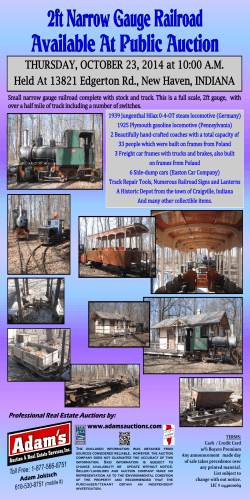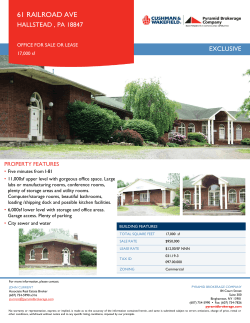
Read the full message.
Message from the Editor By John Gruber [email protected] My goals for this issue and future issues of the Quarterly are to continue coverage of R&LHS, stressing its stature as the oldest railroad history organization in North America, and to open a conversation about the importance of railroad history in American life, now and in the future. R&LHS has for 93 years promoted and educated the public about railroad history through its journal, awards program, archives, and other activities. Together with everyone else associated with the organization, I want to encourage young and old to embrace railroad history as an active, vibrant concept. A benefit for R&LHS members, the Quarterly will continue to inform them about activities of their organization, especially its contributions to national railroad history. The journal needs no introduction to members, since they have been receiving it twice a year, many times for decades. The Quarterly will continue to feature such items as reports about the annual members meeting, railroad history awards, research grants, board and financial activity, membership development, membership news, and short but significant articles about railroad history and preservation. We will seek out young authors. The long-running series highlighting areas for railroad research will continue. With assistance from John W. White Jr., a retired Smithsonian curator and former editor of Railroad History, and others, we will take a look at the origins of our organization and its early members. This cooperative effort will begin building a foundation for a centennial celebration in 2021. What was the role of Charles Fisher and his father, Herbert Fisher, in getting the R&LHS off the ground? Who were others? What forces and what persons have kept it going? We intend that the conversations will range far and wide. We will relate railroad history to history in general. We will take a look at what William Cronon, a distinguished professor of history, geography, and environmental studies at the University of WisconsinMadison and president of the American Historical Association in 2012, had to say about history. “More than anything else, though, we need to keep telling stories about why the past matters and why all of us should care about it. Nothing is more important, for only by the never-ending telling of such stories is the dead past reborn into memory to become living history, over and over and over again,” he said in his presidential address, “Storytelling.” Cronon is writing a wide-ranging history of Portage, Wisconsin, to explore ways of integrating environmental and social historical methods with nontraditional narrative literary forms. How does Cronon relate that community—and, by extension, communities across the continent—to the role the railroad played in American life? We’ll try to ask him. Portage remains a railroad town, where freight train crews change even today. Its county, Columbia, had 98 railroad workers as residents in 2013, with more in adjacent counties. We will look at what remains undone, beginning with a discussion with Maury Klein, who in 1994 wrote Unfinished Business: the Railroad in American Life. Today, he says, “there is a lot of unfinished business still. Since I wrote that there have been some good railroad histories. There have been some good studies in particular The Farm Security Administration-Office of War Information documented diversity, as in this 1943 photo of Manny W. Hughes (1900-1982), a car repair man in Topeka. But even today diversity is underrepresented in railroad history research. An as yet unanswered question: did the Santa Fe maintain separate toilet and wash rooms for persons of color in Topeka as it did in Shopton, Iowa? Photo by Jack Delano, Library of Congress areas of railroad history. There is still an awful lot of work that could be done. There are still a lot of railroads that still need a history. There are a lot of aspects of railroading and the role it played in American life that have yet to be really explored.” Recognition of the contributions of photography as a business tool and as a part of the history of business also deserves more than a mere glance in the treatment of what made America grow and prosper. I wrote about Andrew J. Russell in Railroad History 208. There is more to talk about. Our website, rlhs.org, and Facebook page are growing stronger and could play increasing roles in introducing railroad history to new audiences. Cronon also has written about history in the digital age, and in his presentations to public audiences he frequently mentions students’ immersion in social media and the Internet, in contrast to their predecessors’ immersion in libraries and archives. We will try to spread the work around, searching for contributions from young and old alike. We want to introduce new generations to reading and writing history and its benefits to public understanding. After the exploration has started, we expect to expand our questions and sources for examination of history—to broaden our horizons about the importance railroad history. All is in keeping with the R&LHS mission, stated on page 4. As we explore ideas for elevating interest in history and railroad history, we hope your spirit moves you to participate, to offer viewpoints and critiques. It will be an interesting and productive journey. Stay tuned. Thanks are due to John Fike, Bob Holzweiss, and Dick Hillman for their editorial work on the Quarterly for the last several years. 3
© Copyright 2025









